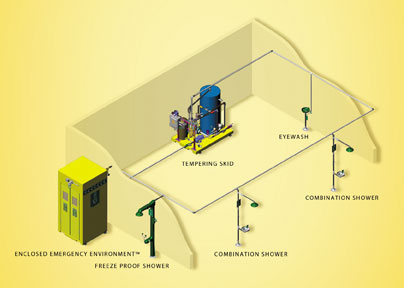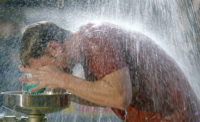
ANSI’s original requirements for the temperature of flushing fluid for emergency showers and eyewashes were ambiguous at best. And even after ANSI’s 2004 revision to the Z358.1 standard clarified its definition of tepid water, non-compliance continues to be an issue. This article takes a look at those ANSI regulations and offers a possible alternative to help larger facilities comply.
What temp is tepid?
In its 1998 revision, the ANSI guideline for emergency showers and eyewashes, Z358.1, included a general requirement that flushing fluid be “tepid.” That initial requirement was somewhat vague, leading to individual interpretation. As a result, it meant different things to different people, including the acceptability of municipally supplied water at the temperature it arrived at each commercial or industrial facility.But source water supply temperatures in most areas can be quite chilly, especially after they’ve run for awhile. This uncomfortable chilling can lead to cessation of the shower or eyewash use cycle prior to the required 15-minute duration. And victims able to tolerate being subjected to cold water for that long run a real risk of hypothermia.
Conversely, weather conditions or processes used in individual plant operations can heat water left standing in piping that leads to emergency equipment, making it dangerously hot if used on an injured victim. Consider how hot water becomes when left standing in your garden hose during a summer car washing session. As you soap up the car, the hose lies on the ground. When you open the sprayer to rinse the car, the output water is substantially hotter than one might expect. Industrial operations can experience even more dramatic temperature changes. Imagine an injured employee in a foundry spraying water heated by adjacent processes into his injured eyes. Not a pretty picture.
In its 2004 revision of the Z358.1 standard, ANSI further clarified the definition of “tepid” to be between 60ºF to below 100ºF. Output flushing fluid must be within that range at equipment start-up and remain there throughout the full 15-minute use cycle.
Interestingly, this more precise definition of the temperature range requirement does not seem to be “biting in.” It’s estimated that almost three years after the release of the 2004 revision, the number of total eyewash/shower installations that flow tempered water remained well below ten percent. While more and more tempering equipment and turn-key systems are sold every day, there seems to be considerable inertia in attaining substantial compliance.

Non-compliance: Paying the price
Delaying compliance can lead to significant regulatory agency exposure. Public records of OSHA fines for non-compliance to ANSI and other standards often reach five figures. While most of these punitive measures involve deviations beyond showers and eyewashes, they could be levied on single instances alone. It’s interesting to note that fines of this magnitude often equal the cost of the changes needed to comply.Specifiers should also realize that the clarity of ANSI’s temperature range requirement could be considered solid proof of negligence in a lawsuit filed on behalf of an injured worker. Consider an example: An injured employee curtails his/her treatment protocol because the emergency shower water is too cold. Should a court determine that the employee sustained a more severe injury, which could have been at least partially mitigated had he or she remained engaged with the shower for the full required period, it could lead to catastrophic litigation consequences.
A viable option?
A good deal of compliance inertia is due to the fact that there is no easy means to provide tempered water to remote shower or eyewash locations in large facilities. Centralized tempering and huge recirculation systems can be expensive, cumbersome and disruptive to install.To address these concerns, a growing number of facilities are opting for smaller recirculation loops, smartly located to provide a “cluster effect” in tempering a portion of the facility’s emergency equipment in a defined area. In effect, several clusters then handle the tempered water needs throughout the plant. This approach can be cost effective, while minimizing impact on the operation during installation and maintenance.
Illustration #1 (above) shows a diagram of one example of an indoor and outdoor cluster. Installing several such engineered solutions in appropriate locations throughout the plant can provide a cost-effective and operationally sound option.
